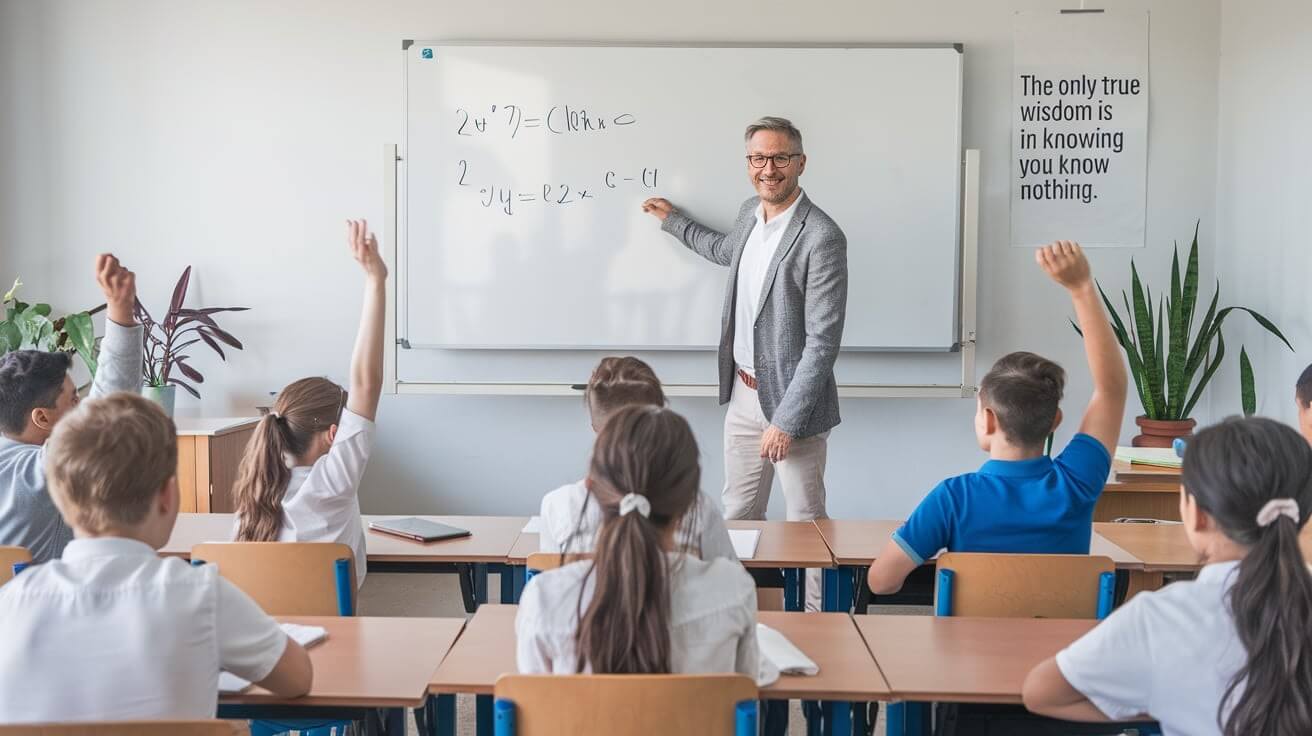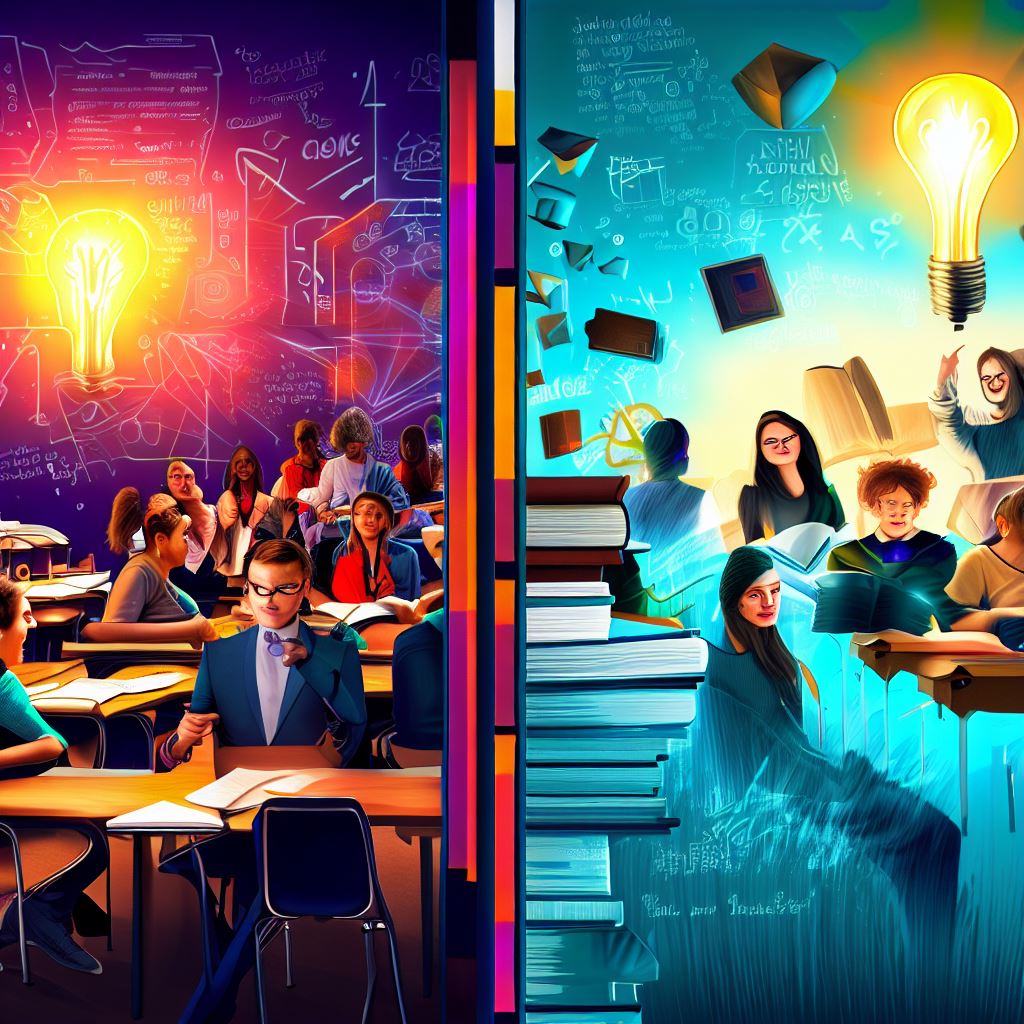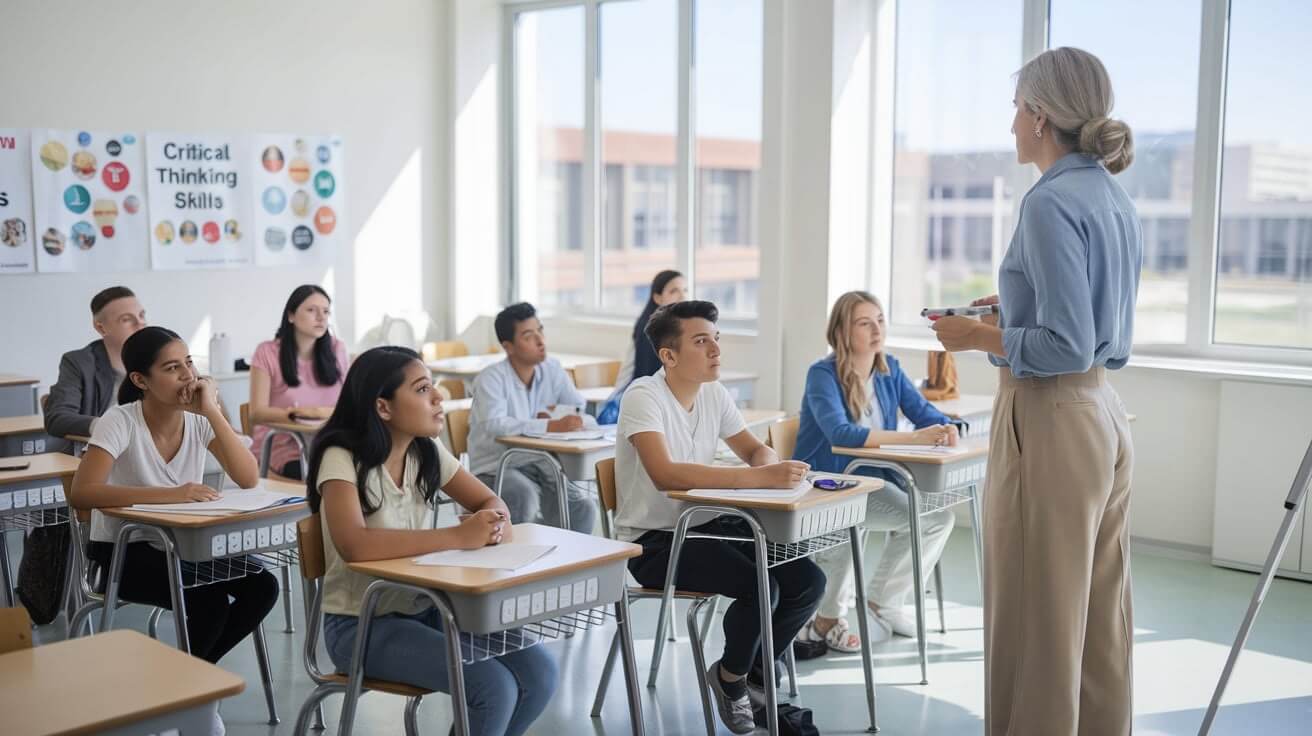
In the classroom and beyond, thinking critically can transform how students learn, solve problems, and prepare for their futures. Whether analyzing an argument, tackling a challenge, or assessing the credibility of a source, critical thinking helps students approach situations with clarity and logic.
In this article, we'll explore why fostering these skills in education is not just a benefit but a necessity. We'll also dive into practical strategies educators can use to cultivate these abilities.
Table of Content
What is Critical Thinking?

Critical thinking involves analyzing and evaluating information carefully to make thoughtful, reasoned decisions. Questioning assumptions, recognizing biases, and considering multiple perspectives before reaching conclusions is essential.
This approach differs significantly from rote memorization, which is solely about recalling information without questioning its source or context. Instead, critical thinking invites active engagement with content, encouraging learners to interpret, analyze, and apply information to real-world situations.
One key benefit of critical thinking is its role in enhancing problem-solving capabilities. By breaking down information into manageable parts, individuals can identify patterns, understand relationships, and evaluate the significance of various elements. For example, when presented with conflicting data, a critical thinker needs to choose more than one source but assesses the validity of each, weighing their reliability and relevance. This process enables them to make informed decisions based on evidence rather than assumptions or incomplete understanding.
Key Aspects of Critical Thinking:
-
Analyzing Information: Breaking complex data into smaller components to uncover relationships and significance.
-
Evaluating Evidence: Examining the credibility, reliability, and validity of information or sources.
-
Problem-Solving: Developing logical solutions by connecting ideas in meaningful ways.
-
Creative Thinking: Exploring alternative approaches and innovative strategies for addressing challenges.
A practical example can be observed in a student researching climate change. Instead of merely compiling a list of statistics, they might evaluate the credibility of their sources, critically examine varying opinions, and construct an argument supported by evidence.
For instance, they could compare data from scientific journals with reports from advocacy organizations, discerning the reliability of each and how it shapes public understanding. This analytical approach fosters deeper comprehension and cultivates skills to navigate complex academic, professional, and personal issues.
Critical thinking prepares individuals to handle nuanced, multifaceted challenges confidently and clearly by emphasizing active interpretation and evaluation. It shifts the focus from merely knowing facts to understanding their implications, ultimately equipping learners with the tools to approach problems thoughtfully and effectively.
Why is Critical Thinking Important in Education?

Incorporating critical thinking into education profoundly impacts students' academic achievements, personal development, and future readiness. It equips them with the skills to navigate a complex, information-driven world.
Education that prioritizes critical thinking enhances learning by fostering the ability to analyze, evaluate, and synthesize information. It also builds a foundation for thoughtful, independent decision-making.
Encourages Independent Thinking
Critical thinking helps students develop the confidence and ability to question information rather than accept it at face value. This independence enables them to assess the credibility of sources, challenge assumptions, and draw conclusions. When students engage critically, they move beyond passive knowledge absorption and become active participants in their learning journey.
For instance, a student reading about historical events might examine how different authors present the same occurrence. They comprehensively understand the topic by comparing narratives, identifying biases, and analyzing motivations. This process deepens their grasp of history and sharpens their ability to scrutinize other information they encounter.
A 2018 study by the Education Testing Service revealed that only 39% of college graduates demonstrate proficiency in critical thinking. This finding highlights a significant gap in higher education outcomes and emphasizes the need to integrate critical thinking skills into curricula early.
Enhances Academic Performance
Critical thinking significantly improves students' ability to process and understand complex ideas. When students learn to break down concepts, identify relationships, and apply logic, their performance across subjects improves. They are better equipped to approach problems holistically, connect theories with real-world applications, and articulate well-reasoned conclusions.
Consider a history student tasked with analyzing primary sources. Rather than merely memorizing dates and events, they evaluate the context, compare differing accounts, and explore the socio-political factors influencing historical decisions. This analytical approach fosters deeper comprehension and allows them to present nuanced insights, elevating their academic work.
A science student conducting a lab experiment might hypothesize, test variables, and critically interpret results to form evidence-based conclusions. This method reinforces their understanding of scientific principles while cultivating transferable skills like problem-solving and logical reasoning.
Prepares Students for the Workplace
Critical thinking is consistently identified as one of the most sought-after skills by employers. Whether in problem-solving, collaboration, or innovation, the ability to think critically enables individuals to adapt and excel in professional environments. Workplace challenges often involve ambiguous or multifaceted issues requiring analysis, creativity, and sound judgment.
A project manager, for instance, must evaluate competing proposals, anticipate potential risks, and devise strategies that align with organizational goals. Employees with critical thinking skills are better equipped to handle these demands and contribute effectively to their teams and organizations.
According to the National Association of Colleges and Employers, 80% of employers rank critical thinking as a top priority when evaluating job candidates. This highlights the increasing value of these skills in an evolving job market where adaptability and innovation are paramount.
Promotes Lifelong Learning
Critical thinkers are naturally curious and continually seek to learn and adapt. This mindset extends beyond the classroom, encouraging a lifetime of exploration and self-improvement. By questioning established norms, seeking diverse perspectives, and embracing change, lifelong learners remain resilient in a rapidly evolving world.
For example, a graduate who develops critical thinking skills during their education may approach career transitions or technological advancements with a problem-solving mindset. Instead of fearing change, they analyze opportunities, assess risks, and pursue informed decisions. This adaptability enhances personal growth and fosters innovation and leadership in their professional lives.
In a real-life example, a software engineer facing the emergence of new programming languages might critically evaluate their relevance, invest in upskilling, and apply their knowledge creatively to design solutions. This approach ensures they remain competitive and capable in their field.
Fosters Personal Empowerment
Beyond academic and professional contexts, critical thinking empowers individuals to navigate daily challenges and make well-informed choices. From understanding financial options to evaluating news reports, critical thinking provides the tools to discern fact from fiction and act responsibly.
For instance, a consumer deciding on a major purchase might research product reviews, consider expert opinions, and weigh long-term value over immediate gratification. This ability to analyze options and prioritize based on evidence leads to more confident and satisfying decisions.
Building a Foundation for Success
Students are equipped with tools that extend far beyond the classroom by emphasizing critical thinking in education. They become independent learners, capable professionals, and engaged citizens who contribute thoughtfully to their communities. Incorporating strategies like questioning, collaborative projects, and problem-solving exercises ensures these skills are taught and deeply ingrained.
Critical thinking is not just an academic practice but a transformative approach to understanding and engaging with the world. As educators, parents, and policymakers, fostering these skills prepares the next generation to face challenges with clarity, creativity, and confidence—paving the way for a more thoughtful and informed society.
Teaching Strategies to Foster Critical Thinking

Educators are pivotal in helping students develop critical thinking skills necessary for academic success and lifelong learning. These strategies go beyond traditional teaching methods, emphasizing active engagement, exploration, and collaboration. Here are some effective approaches:
Socratic Questioning
Socratic questioning remains one of the most powerful tools for empowering critical thinking in the classroom. By encouraging students to engage with open-ended questions, teachers prompt deeper exploration of ideas and a more nuanced understanding of concepts. This approach requires students to articulate their thoughts, evaluate evidence, and refine their reasoning.
A literature teacher might ask, "What motivations drive the protagonist's actions? How do these choices reflect the historical or cultural context of the time?" Such questions push students beyond comprehension, analyzing character motivations, historical influences, and societal implications.
Socratic questioning develops analytical skills by challenging students to justify their answers with evidence. This method encourages active participation and fosters a learning environment where curiosity thrives. Instead of simply absorbing information, students are guided to construct their understanding, making the learning process more meaningful.
Problem-Based Learning (PBL)
Problem-based learning places students at the center of real-world challenges, encouraging them to research, collaborate, and propose solutions. This hands-on knowledge bridges the theoretical and practical application gap, making learning relevant and engaging.
In a science class, students might be tasked with designing a model for sustainable energy use in their school. To complete the project, they would research renewable energy technologies, analyze environmental data, and consider economic feasibility. This process compels them to integrate information from multiple sources and think critically about trade-offs and constraints.
PBL enhances critical thinking and builds problem-solving and teamwork skills. Students learn to approach challenges methodically, breaking down complex problems into manageable parts and seeking innovative solutions.
Collaborative Learning
Collaborative learning environments encourage students to collaborate, share ideas, and evaluate diverse perspectives. Group discussions, projects, and peer reviews expose students to various viewpoints, enhancing their ability to assess information and construct balanced arguments critically.
A report published in the Journal of Educational Psychology found that students in collaborative settings were 25% more likely to demonstrate critical thinking skills than those in individual learning environments. This increase is attributed to the exchange of ideas and constructive feedback inherent in group work.
In a history class, students could divide into groups to debate the reasons for a historical conflict. Each group might represent a different perspective, requiring them to research and present arguments while addressing counterarguments posed by their peers.
Collaborative learning builds communication and teamwork skills while fostering an appreciation for diverse perspectives. It also creates a supportive environment where students feel encouraged to question and refine their understanding.
Incorporating Technology
Digital tools have become invaluable in making learning more dynamic and interactive. Simulations, interactive quizzes, discussion forums, and debate platforms are examples of how technology can enhance critical thinking.
Debate platforms allow students to analyze arguments and counterarguments in real-time. For instance, during a unit on environmental policy, students could engage in an online debate, presenting data to support their positions while critiquing opposing views.
Technology allows students to engage actively with content, offering immediate feedback and fostering independent exploration. Simulation tools can replicate real-world scenarios, helping students apply their knowledge to practical problems in a risk-free environment.
Real-World Application of These Strategies
When these teaching methods are implemented effectively, the impact extends beyond the classroom. For instance, at a middle school in Oregon, a curriculum emphasizing problem-based learning and collaborative projects resulted in a 20% increase in student participation. Teachers reported that students became more confident in their ability to analyze complex topics and articulate their ideas clearly.
Similarly, in a pilot program using technology to enhance critical thinking, high school students showed a marked improvement in their ability to evaluate the credibility of online information. They developed stronger analytical and decision-making skills by participating in digital discussions and interactive simulations.
Fostering critical thinking in students requires intentional teaching strategies that prioritize active participation, collaboration, and real-world problem-solving. Socratic questioning encourages thoughtful dialogue, problem-based learning bridges theory and practice, collaborative environments nurture diverse perspectives, and technology makes learning dynamic and accessible. By implementing these approaches, educators can equip students with the tools to connect to an increasingly complex world confidently and clearly. These strategies do more than teach content—they inspire a mindset of inquiry and adaptability that prepares students for lifelong success.
Challenges in Teaching Critical Thinking

Despite critical thinking's many benefits, integrating it into classrooms takes time and effort. From rigid curricula to resource limitations, these hurdles can impede students' development of critical thinking skills. Recognizing these barriers and addressing them strategically is essential for fostering a learning environment that prioritizes analytical and evaluative skills. Below, I have for you the key challenges and potential solutions that are explored.
Curriculum Constraints
One of the most significant obstacles in teaching critical thinking is the dominance of standardized testing in educational systems. These assessments often prioritize rote memorization and recall over analytical skills, leaving little room for activities that foster deep thinking. Teachers may experience pressure to "teach to the test," focusing on meeting benchmarks rather than nurturing intellectual curiosity.
A typical standardized exam in mathematics may require students to solve equations using predetermined formulas. While this approach tests procedural knowledge, it rarely encourages students to explore why those formulas work or how they can be applied creatively to real-world problems.
Teachers can integrate critical thinking exercises into existing frameworks to address this issue. For instance, a math teacher could incorporate word problems that require students to analyze scenarios and determine the most appropriate solution. Similarly, discussions about character motivations or thematic elements can be added to standard lesson plans in literature classes. These small adaptations make room for critical thinking without compromising curriculum requirements.
Resource Limitations
Another challenge is the need for more tools and professional development opportunities available to many educators. Critical thinking requires innovative teaching methods and resources, such as case studies, interactive technologies, and collaborative activities. However, not all schools have the infrastructure or funding to support these initiatives.
Research from the Learning Policy Institute shows that schools investing in teacher training programs experience a notable improvement in both student engagement and teacher effectiveness. For example, when educators receive training in Socratic questioning or project-based learning, they are better equipped to facilitate discussions that promote deeper understanding.
Institutions can address this gap by prioritizing professional development. Workshops, online courses, and peer mentoring programs focused on critical thinking strategies can give teachers the tools they need to succeed. Additionally, partnerships with local organizations or businesses can offer access to resources like guest speakers, case studies, and hands-on learning opportunities.
Student Readiness
Students accustomed to traditional learning methods may find critical thinking challenging at first. This is especially true in environments where passive learning—listening to lectures and memorizing facts—has been the norm. Critical thinking requires active participation, which can feel unfamiliar and intimidating to some learners.
A student asked to evaluate the credibility of multiple sources in a research project may need to be taught how to identify bias or assess evidence. This difficulty can lead to frustration and disengagement.
The gradual introduction of critical thinking tasks can ease the transition. Teachers might begin with simple activities, such as asking students to evaluate and differentiate two concepts, before moving on to more complex tasks like debating ethical dilemmas or designing solutions to real-world problems. Consistent practice and positive reinforcement help build students' confidence and skills.
Assessing Critical Thinking Skills
Effective assessment methods must be implemented to ensure students develop critical thinking skills. These assessments should go beyond traditional exams to evaluate how students apply their thinking meaningfully. Below are some methods that have proven effective:
Performance Tasks
Performance tasks place students in real-world scenarios, requiring them to analyze situations, make decisions, and justify reasoning. These tasks provide insight into how students apply their knowledge and problem-solving abilities.
In a business class, students could be asked to analyze market trends and develop a strategy for launching a new product. This task would involve interpreting data, considering consumer needs, and proposing actionable solutions, all of which would demonstrate critical thinking.
Reflective Journals
Reflective journals encourage students to document their thought processes, including how they approach problems, evaluate options, and make decisions. This practice enhances self-awareness and critical evaluation, providing valuable insights for students and teachers.
By reviewing journal entries, teachers can identify student reasoning patterns, pinpoint improvement areas, and tailor instruction to address specific needs.
Open-Ended Assessments
Open-ended questions allow students to explain their reasoning in detail, offering a clearer picture of their analytical abilities than multiple-choice tests. These assessments challenge students to think deeply, articulate their thoughts, and support their conclusions with evidence.
Instead of asking a science student to name the parts of a cell, an open-ended question might prompt them to explain how a malfunction in one part could affect the entire system. This approach requires students to synthesize information and demonstrate a thorough understanding of the topic.
Real-Life Impact: A Case Study
The benefits of prioritizing critical thinking in education are evident in real-world examples. At a middle school in California, a critical thinking initiative centered around project-based learning was introduced. Over a year, teachers incorporated activities that required students to collaborate on solving real-world problems, such as designing eco-friendly community projects or analyzing historical events from multiple perspectives.
The results were striking:
-
Student participation increased by 30%.
-
Standardized test scores improved by 15%, particularly in subjects that need analytical skills, such as science and social studies.
-
Teachers reported heightened enthusiasm for learning, with students actively contributing to discussions and demonstrating greater confidence in their abilities.
This case illustrates how even small shifts toward critical thinking can profoundly impact student outcomes, both academically and emotionally. By equipping students with the skills to analyze, evaluate, and solve problems, educators prepare them for success in school, work, and life.
While challenges in teaching critical thinking exist, they are manageable. Educators can create environments where critical thinking thrives by addressing curriculum constraints, investing resources, and supporting students as they adapt to new learning methods. Assessing these skills through performance tasks, reflective journals, and open-ended assessments ensures that students learn and apply their knowledge meaningfully.
Real-world examples, like the success of the California middle school initiative, demonstrate the transformative power of critical thinking education. As educators, overcoming these hurdles means teaching students what to think and empowering them with the tools to think for themselves. This approach ultimately fosters a generation of thoughtful, innovative, and adaptable individuals ready to meet the challenges of an ever-changing world.
Conclusion
Teaching students to think critically prepares them for academic success and informed, thoughtful lives. Educators can cultivate skills that last a lifetime by incorporating questioning, collaboration, and real-world problem-solving into classrooms.
To create a world of empowered learners, let's ask one question: How can we think more critically about teaching?
FAQs
1. How can parents encourage critical thinking at home? Encourage open-ended conversations, provide puzzles or challenges, and model thoughtful decision-making in daily life.
2. Are critical thinking skills teachable? Absolutely! With consistent practice and the right strategies, anyone can develop critical thinking.
3. How does critical thinking impact career success? It enables professionals to analyze problems, collaborate effectively, and innovate—skills valued in any industry.
4. What are some critical thinking exercises for young learners? Activities like sorting fact from opinion, debating age-appropriate topics, and analyzing simple scenarios help build foundational skills.
5. Why is collaboration essential for critical thinking? It introduces diverse perspectives, challenges students to reassess assumptions, and strengthens their reasoning.
By nurturing critical thinking, we unlock education's potential to create a brighter future for all learners. Let's prioritize this—one question, idea, and solution at a time.
Education Critical Thinking Skills Learning Skills




